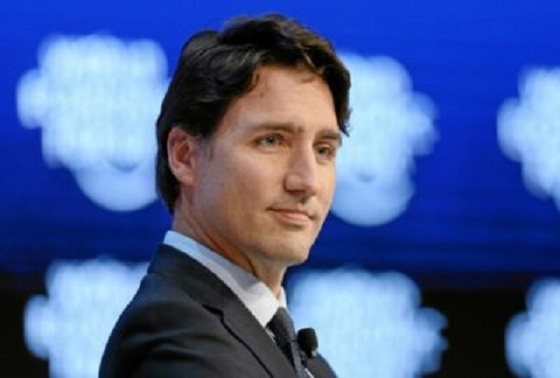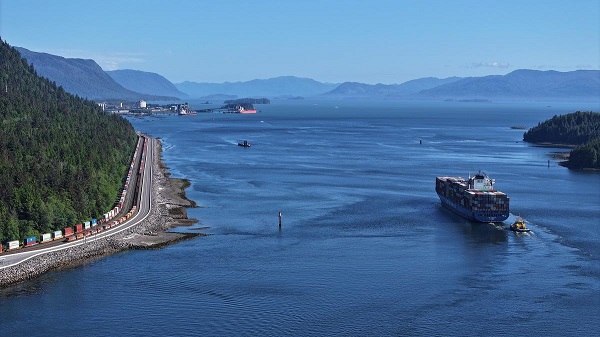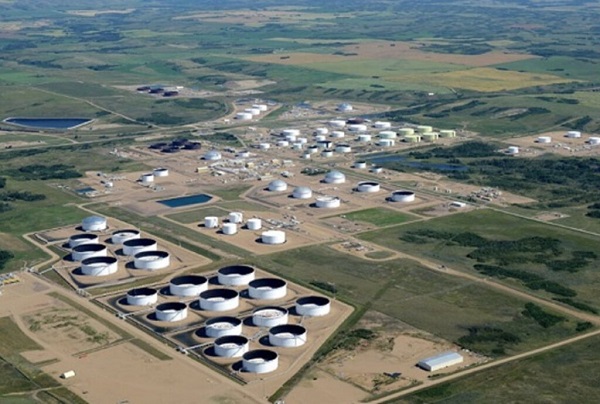Energy
Canadian Gas Association Writes a Letter to Prime Minister Justin Trudeau Highlighting the Importance of Natural Gas Energy Choice for Canadians

From EnergyNow.ca
On January 29, 2024, the Canadian Gas Association (CGA) sent a letter to Prime Minister Justin Trudeau, emphasizing the significance of the natural gas energy option for Canadians, a need underscored by the recent severe weather conditions in Western Canada.
The letter reads as follows:
Canada’s energy delivery companies had their work cut out for them over the last few weeks, ensuring the country could get through a period of extreme cold temperatures. The polar vortex that locked in across the continent only underscored how important an energy system with many options is to our overall well-being. I thought I would expand on this point in my first letter to you in 2024.
The second week of January saw temperatures in parts of the country drop well into the minus 40s, with windchill in the minus 50s. This triggered alerts from various authorities to reduce electricity use. Around 4 pm in Alberta on January 12th wind and solar generation facilities were operating at only a few percentage points of their capacity. But power was desperately needed. Luckily, a combination of in-province and neighbouring jurisdiction power sources – like natural gas-powered plants – could help meet the power needs of the province.
It is worth drawing attention to the fact that the alerts were all about a single energy system – the electricity grid. While that grid was under strain due in part to low renewable energy generation availability, the natural gas delivery system (a separate system that delivers gas energy, not electrons) was delivering approximately 9 times the energy and operating without any alerts required.
The contribution of the gas system is really worth emphasizing.
Nationally, over an average year, electricity meets just over 20% of our energy needs. Natural gas directly delivered to customers – residential, commercial and industrial – meets almost twice that amount, or just under 40% and liquid fuels like gasoline and diesel meet the balance. But at certain times of the year, such as during the recent January freeze, the differential between what natural gas and electricity deliver grows dramatically. At points earlier this month Alberta had use of roughly 12,000 megawatts of electric power and over 110,000 megawatts of gas energy equivalent.
And yet it was the electric system, not the natural gas system, that was threatened.
Media coverage during and after the freeze referenced how the electric system is threatened by extreme weather and needs to be built out to meet demand. But to suggest that the electric system could ever meet the energy delivered by natural gas over the gas delivery system is simply unrealistic. Do those who advocate for the electrification of all energy, especially peak heating needs, pretend that we have either the means, the resources, or the dollars, to build out an electric system that could meet roughly nine times the load of the gas system? Do advocates of natural gas bans appreciate that banning natural gas power generation would leave us in situations of actual shortage – a terrifying spectacle in the event of minus 50 degree weather?
Again, the point here is to underscore the value proposition of natural gas and the infrastructure that delivers it: the reliability these provide is extraordinarily important. This value is particularly well demonstrated when severe weather – a Canadian reality – hits us. We have to stop talking about eliminating the choice of energy options like natural gas, and relying exclusively on one energy delivery system, like electricity. Each delivery system has its own advantages, and natural gas is particularly well suited to meet heating needs. That should never be overlooked, as this month’s weather events reminded us.
Prime Minister, when it comes to energy – in supply options, and in delivery systems – diversity truly is our strength in Canada. We must maintain natural gas as an option for reliability, for affordability, and for sustainability – all of which are essential for our country’s energy security and the wellbeing of the Canadian consumer.
Respectfully,
Timothy M. Egan
President and CEO, Canadian Gas Association
Chair, NGIF Capital Corporation
About CGA
The Canadian Gas Association (CGA) is the voice of Canada’s gaseous energy delivery industry, including natural gas, renewable natural gas (RNG) and hydrogen. CGA membership includes energy distribution and transmission companies, equipment manufacturers, and suppliers of goods and services to the industry. CGA’s utility members are Canadian-owned and active in eight provinces and one territory. The Canadian natural gas delivery industry meets 38 per cent of Canada’s energy needs through a network of almost 584,000 kilometers of underground infrastructure. The versatility and resiliency of this infrastructure allows it to deliver an ever-changing gas supply mix to 7.6 million customer locations representing approximately two-thirds of Canadians. CGA members ensure Canadians get the affordable, reliable, clean gaseous energy they want and need. CGA is also working to constantly improve that gaseous energy offering, by driving forward innovation through the Natural Gas Innovation Fund (NGIF).
SOURCE Canadian Gas Association
Economy
Trump opens door to Iranian oil exports

This article supplied by Troy Media.
U.S. President Donald Trump’s chaotic foreign policy is unravelling years of pressure on Iran and fuelling a surge of Iranian oil into global markets. His recent pivot to allow China to buy Iranian crude, despite previously trying to crush those exports, marks a sharp shift from strategic pressure to transactional diplomacy.
This unpredictability isn’t just confusing allies—it’s transforming global oil flows. One day, Trump vetoes an Israeli plan to assassinate Iran’s supreme leader, Ayatollah Khamenei. Days later, he calls for Iran’s unconditional surrender. After announcing a ceasefire between Iran, Israel and the United States, Trump praises both sides then lashes out at them the next day.
The biggest shock came when Trump posted on Truth Social that “China can now continue to purchase Oil from Iran. Hopefully, they will be purchasing plenty from the U.S., also.” The statement reversed the “maximum pressure” campaign he reinstated in February, which aimed to drive Iran’s oil exports to zero. The campaign reimposes sanctions on Tehran, threatening penalties on any country or company buying Iranian crude,
with the goal of crippling Iran’s economy and nuclear ambitions.
This wasn’t foreign policy—it was deal-making. Trump is brokering calm in the Middle East not for strategy, but to boost American oil sales to China. And in the process, he’s giving Iran room to move.
The effects of this shift in U.S. policy are already visible in trade data. Chinese imports of Iranian crude hit record levels in June. Ship-tracking firm Vortexa reported more than 1.8 million barrels per day imported between June 1 and 20. Kpler data, covering June 1 to 27, showed a 1.46 million bpd average, nearly 500,000 more than in May.
Much of the supply came from discounted May loadings destined for China’s independent refineries—the so-called “teapots”—stocking up ahead of peak summer demand. After hostilities broke out between Iran and Israel on June 12, Iran ramped up exports even further, increasing daily crude shipments by 44 per cent within a week.
Iran is under heavy U.S. sanctions, and its oil is typically sold at a discount, especially to China, the world’s largest oil importer. These discounted barrels undercut other exporters, including U.S. allies and global producers like Canada, reducing global prices and shifting power dynamics in the energy market.
All of this happened with full knowledge of the U.S. administration. Analysts now expect Iranian crude to continue flowing freely, as long as Trump sees strategic or economic value in it—though that position could reverse without warning.
Complicating matters is progress toward a U.S.-China trade deal. Commerce Secretary Howard Lutnick told reporters that an agreement reached in May has now been finalized. China later confirmed the understanding. Trump’s oil concession may be part of that broader détente, but it comes at the cost of any consistent pressure on Iran.
Meanwhile, despite Trump’s claims of obliterating Iran’s nuclear program, early reports suggest U.S. strikes merely delayed Tehran’s capabilities by a few months. The public posture of strength contrasts with a quieter reality: Iranian oil is once again flooding global markets.
With OPEC+ also boosting output monthly, there is no shortage of crude on the horizon. In fact, oversupply may once again define the market—and Trump’s erratic diplomacy is helping drive it.
For Canadian producers, especially in Alberta, the return of cheap Iranian oil can mean downward pressure on global prices and stiffer competition in key markets. And with global energy supply increasingly shaped by impulsive political decisions, Canada’s energy sector remains vulnerable to forces far beyond its borders.
This is the new reality: unpredictability at the top is shaping the oil market more than any cartel or conflict. And for now, Iran is winning.
Toronto-based Rashid Husain Syed is a highly regarded analyst specializing in energy and politics, particularly in the Middle East. In addition to his contributions to local and international newspapers, Rashid frequently lends his expertise as a speaker at global conferences. Organizations such as the Department of Energy in Washington and the International Energy Agency in Paris have sought his insights on global energy matters.
Troy Media empowers Canadian community news outlets by providing independent, insightful analysis and commentary. Our mission is to support local media in helping Canadians stay informed and engaged by delivering reliable content that strengthens community connections and deepens understanding across the country.
Canadian Energy Centre
Alberta oil sands legacy tailings down 40 per cent since 2015

Wapisiw Lookout, reclaimed site of the oil sands industry’s first tailings pond, which started in 1967. The area was restored to a solid surface in 2010 and now functions as a 220-acre watershed. Photo courtesy Suncor Energy
From the Canadian Energy Centre
By CEC Research
Mines demonstrate significant strides through technological innovation
Tailings are a byproduct of mining operations around the world.
In Alberta’s oil sands, tailings are a fluid mixture of water, sand, silt, clay and residual bitumen generated during the extraction process.
Engineered basins or “tailings ponds” store the material and help oil sands mining projects recycle water, reducing the amount withdrawn from the Athabasca River.
In 2023, 79 per cent of the water used for oil sands mining was recycled, according to the latest data from the Alberta Energy Regulator (AER).
Decades of operations, rising production and federal regulations prohibiting the release of process-affected water have contributed to a significant accumulation of oil sands fluid tailings.
The Mining Association of Canada describes that:
“Like many other industrial processes, the oil sands mining process requires water.
However, while many other types of mines in Canada like copper, nickel, gold, iron ore and diamond mines are allowed to release water (effluent) to an aquatic environment provided that it meets stringent regulatory requirements, there are no such regulations for oil sands mines.
Instead, these mines have had to retain most of the water used in their processes, and significant amounts of accumulated precipitation, since the mines began operating.”
Despite this ongoing challenge, oil sands mining operators have made significant strides in reducing fluid tailings through technological innovation.
This is demonstrated by reductions in “legacy fluid tailings” since 2015.
Legacy Fluid Tailings vs. New Fluid Tailings
As part of implementing the Tailings Management Framework introduced in March 2015, the AER released Directive 085: Fluid Tailings Management for Oil Sands Mining Projects in July 2016.
Directive 085 introduced new criteria for the measurement and closure of “legacy fluid tailings” separate from those applied to “new fluid tailings.”
Legacy fluid tailings are defined as those deposited in storage before January 1, 2015, while new fluid tailings are those deposited in storage after January 1, 2015.
The new rules specified that new fluid tailings must be ready to reclaim ten years after the end of a mine’s life, while legacy fluid tailings must be ready to reclaim by the end of a mine’s life.
Total Oil Sands Legacy Fluid Tailings
Alberta’s oil sands mining sector decreased total legacy fluid tailings by approximately 40 per cent between 2015 and 2024, according to the latest company reporting to the AER.
Total legacy fluid tailings in 2024 were approximately 623 million cubic metres, down from about one billion cubic metres in 2015.
The reductions are led by the sector’s longest-running projects: Suncor Energy’s Base Mine (opened in 1967), Syncrude’s Mildred Lake Mine (opened in 1978), and Syncrude’s Aurora North Mine (opened in 2001). All are now operated by Suncor Energy.
The Horizon Mine, operated by Canadian Natural Resources (opened in 2009) also reports a significant reduction in legacy fluid tailings.
The Muskeg River Mine (opened in 2002) and Jackpine Mine (opened in 2010) had modest changes in legacy fluid tailings over the period. Both are now operated by Canadian Natural Resources.
Imperial Oil’s Kearl Mine (opened in 2013) and Suncor Energy’s Fort Hills Mine (opened in 2018) have no reported legacy fluid tailings.
Suncor Energy Base Mine
Between 2015 and 2024, Suncor Energy’s Base Mine reduced legacy fluid tailings by approximately 98 per cent, from 293 million cubic metres to 6 million cubic metres.
Syncrude Mildred Lake Mine
Between 2015 and 2024, Syncrude’s Mildred Lake Mine reduced legacy fluid tailings by approximately 15 per cent, from 457 million cubic metres to 389 million cubic metres.
Syncrude Aurora North Mine
Between 2015 and 2024, Syncrude’s Aurora North Mine reduced legacy fluid tailings by approximately 25 per cent, from 102 million cubic metres to 77 million cubic metres.
Canadian Natural Resources Horizon Mine
Between 2015 and 2024, Canadian Natural Resources’ Horizon Mine reduced legacy fluid tailings by approximately 36 per cent, from 66 million cubic metres to 42 million cubic metres.
Total Oil Sands Fluid Tailings
Reducing legacy fluid tailings has helped slow the overall growth of fluid tailings across the oil sands sector.
Without efforts to reduce legacy fluid tailings, the total oil sands fluid tailings footprint today would be approximately 1.6 billion cubic metres.
The current fluid tailings volume stands at approximately 1.2 billion cubic metres, up from roughly 1.1 billion in 2015.
The unaltered reproduction of this content is free of charge with attribution to the Canadian Energy Centre.
-

 Opinion1 day ago
Opinion1 day agoBlind to the Left: Canada’s Counter-Extremism Failure Leaves Neo-Marxist and Islamist Threats Unchecked
-

 Business2 days ago
Business2 days agoWhy it’s time to repeal the oil tanker ban on B.C.’s north coast
-

 Alberta1 day ago
Alberta1 day agoAlberta Provincial Police – New chief of Independent Agency Police Service
-

 Alberta2 days ago
Alberta2 days agoPierre Poilievre – Per Capita, Hardisty, Alberta Is the Most Important Little Town In Canada
-

 COVID-191 day ago
COVID-191 day agoTop COVID doctor given one of Canada’s highest honors
-

 Business2 days ago
Business2 days agoLatest shakedown attempt by Canada Post underscores need for privatization
-

 MxM News2 days ago
MxM News2 days agoUPenn strips Lia Thomas of women’s swimming titles after Title IX investigation
-

 Agriculture8 hours ago
Agriculture8 hours agoCanada’s supply management system is failing consumers








